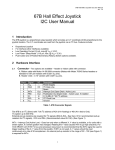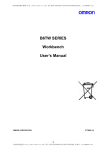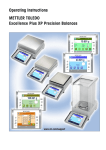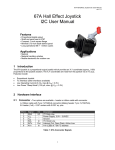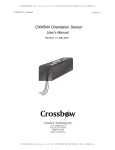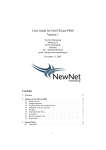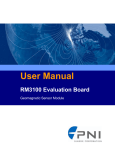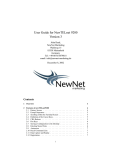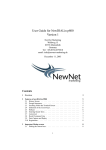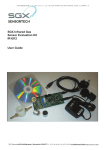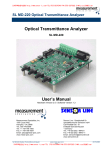Download User Manual SmartSens 3D MagIC
Transcript
SUNSTAR传感与控制 http://www.sensor-ic.com/ TEL:0755-83376549 FAX:0755-83376182E-MAIL: [email protected] User Manual SmartSens 3D MagIC Sensor Controller ASIC SUNSTAR自动化 http://www.sensor-ic.com/ TEL: 0755-83376489 FAX:0755-83376182 E-MAIL: [email protected] SUNSTAR传感与控制 http://www.sensor-ic.com/ TEL:0755-83376549 FAX:0755-83376182E-MAIL: [email protected] Table of Contents 1 2 3 4 5 6 7 COPYRIGHT & WARRANTY INFORMATION ............................................................ 4 INTRODUCTION .......................................................................................................... 5 SPECIFICATIONS ....................................................................................................... 6 3.1 DEVICE CHARACTERISTICS ........................................................................ 6 3.2 TYPICAL OPERATING CHARACTERISTICS ................................................ 8 3.3 DIMENSIONS AND PACKAGING ................................................................... 9 3.4 SOLDERING ................................................................................................. 12 OVERVIEW AND PIN-OUT........................................................................................ 13 4.1 OVERVIEW ................................................................................................... 13 4.2 IDLE MODE ................................................................................................... 15 4.3 3D MAGIC PINOUT AND CONNECTIONS .................................................. 15 SPI INTERFACE ........................................................................................................ 17 5.1 SPI PINS........................................................................................................ 17 5.1.1 SCLK (Serial Clock Input)................................................................. 17 5.1.2 SSN (Slave Select) ........................................................................... 17 5.1.3 MISO (Serial Out) ............................................................................. 17 5.1.4 MOSI (Serial In) ................................................................................ 17 5.2 HARDWARE HANDSHAKING PINS ............................................................. 18 5.2.1 DRDY (Data Ready) ......................................................................... 18 5.2.2 CLEAR (Clear Command Register) ................................................. 18 5.3 SPI INTERFACE OPERATION ..................................................................... 18 OPERATION – STANDARD MODE .......................................................................... 21 6.1 COMMAND REGISTER ................................................................................ 21 6.1.1 Initiate Sensor Measurement ........................................................... 21 6.1.2 Read/Write to a Cycle Count Register ............................................. 22 6.2 CYCLE COUNT REGISTERS ....................................................................... 22 6.3 MAKING A MEASUREMENT ........................................................................ 23 OPERATION – LEGACY MODE ............................................................................... 25 7.1 COMMAND REGISTER ................................................................................ 25 7.1.1 Initiate Sensor Measurement ........................................................... 25 7.1.2 Read/Write to Clock Set Register ..................................................... 26 7.2 CLOCK SET REGISTER ............................................................................... 27 7.2.1 Clock Divide ...................................................................................... 27 7.2.2 Period Divide .................................................................................... 28 7.3 MAKING A MEASUREMENT ........................................................................ 29 SUNSTAR自动化 http://www.sensor-ic.com/ TEL: 0755-83376489 FAX:0755-83376182 E-MAIL: [email protected] SUNSTAR传感与控制 http://www.sensor-ic.com/ TEL:0755-83376549 FAX:0755-83376182E-MAIL: [email protected] List of Figures Figure 3-1: Figure 3-2: Figure 3-3: Figure 3-4: Figure 3-5: Figure 3-6: Figure 3-7: Figure 4-1: Figure 4-2: Figure 5-1: Figure 5-2: Figure 5-3: Gain vs. Cycle Counts............................................................................................ 8 Maximum Data Rate per Axis vs. Cycle Counts .................................................... 8 3D MagIC MLF Mechanical Drawing ..................................................................... 9 3D MagIC MLF Tape Dimensions ........................................................................ 10 3D MagIC Die Pad Layout ................................................................................... 10 Example Wire Bonding Layout for Legacy 11096 ASIC Applications .................. 11 Recommended Solder Reflow Profile .................................................................. 12 Typical 3D MagIC MLF Application Circuit .......................................................... 13 Biasing Diagram ................................................................................................... 14 SPI Measure/Read Data Timing Diagram – Standard Mode ............................... 19 SPI Measure/Read Data Timing Diagram – Legacy Mode .................................. 19 SPI Read/Write Data Timing ................................................................................ 20 List of Tables Table 3-1: Table 3-2: Table 3-3: Table 3-4: Table 4-1: Table 5-1: Table 6-1: Absolute Maximum Ratings .................................................................................... 6 Recommended Operating Conditions ..................................................................... 6 Electrical Characteristics ......................................................................................... 7 Recommended Solder Processing Parameters .................................................... 12 3D MagIC Pin Assignments .................................................................................. 16 Timing Specifications ............................................................................................ 20 Cycle Count Registers........................................................................................... 23 3D MagIC User Manual – May 24, 2010 Page 3 of 29 SUNSTAR自动化 http://www.sensor-ic.com/ TEL: 0755-83376489 FAX:0755-83376182 E-MAIL: [email protected] SUNSTAR传感与控制 http://www.sensor-ic.com/ TEL:0755-83376549 FAX:0755-83376182E-MAIL: [email protected] 1 Copyright & Warranty Information © Copyright PNI Sensor Corporation 2010 All Rights Reserved. Reproduction, adaptation, or translation without prior written permission is prohibited, except as allowed under copyright laws. Revised April 2010: for the most recent version visit our website at www.pnicorp.com PNI Sensor Corporation 133 Aviation Blvd, Suite 101 Santa Rosa, CA 95403, USA Tel: (707) 566-2260 Fax: (707) 566-2261 Warranty and Limitation of Liability. PNI Sensor Corporation ("PNI") manufactures its Products from parts and components that are new or equivalent to new in performance. PNI warrants that each Product to be delivered hereunder, if properly used, will, for ninety (90) days following the date of shipment unless a different warranty time period for such Product is specified: (i) in PNI’s Price List in effect at time of order acceptance; or (ii) on PNI’s web site (www.pnicorp.com) at time of order acceptance, be free from defects in material and workmanship and will operate in accordance with PNI’s published specifications and documentation for the Product in effect at time of order. PNI will make no changes to the specifications or manufacturing processes that affect form, fit, or function of the Product without written notice to the Customer, however, PNI may at any time, without such notice, make minor changes to specifications or manufacturing processes that do not affect the form, fit, or function of the Product. This warranty will be void if the Products’ serial number, or other identification marks have been defaced, damaged, or removed. This warranty does not cover wear and tear due to normal use, or damage to the Product as the result of improper usage, neglect of care, alteration, accident, or unauthorized repair. THE ABOVE WARRANTY IS IN LIEU OF ANY OTHER WARRANTY, WHETHER EXPRESS, IMPLIED, OR STATUTORY, INCLUDING, BUT NOT LIMITED TO, ANY WARRANTY OF MERCHANTABILITY, FITNESS FOR ANY PARTICULAR PURPOSE, OR ANY WARRANTY OTHERWISE ARISING OUT OF ANY PROPOSAL, SPECIFICATION, OR SAMPLE. PNI NEITHER ASSUMES NOR AUTHORIZES ANY PERSON TO ASSUME FOR IT ANY OTHER LIABILITY. If any Product furnished hereunder fails to conform to the above warranty, Customer’s sole and exclusive remedy and PNI’s sole and exclusive liability will be, at PNI’s option, to repair, replace, or credit Customer’s account with an amount equal to the price paid for any such Product which fails during the applicable warranty period provided that (i) Customer promptly notifies PNI in writing that such Product is defective and furnishes an explanation of the deficiency; (ii) such Product is returned to PNI’s service facility at Customer’s risk and expense; and (iii) PNI is satisfied that claimed deficiencies exist and were not caused by accident, misuse, neglect, alteration, repair, improper installation, or improper testing. If a Product is defective, transportation charges for the return of the Product to Customer within the United States and Canada will be paid by PNI. For all other locations, the warranty excludes all costs of shipping, customs clearance, and other related charges. PNI will have a reasonable time to make repairs or to replace the Product or to credit Customer’s account. PNI warrants any such repaired or replacement Product to be free from defects in material and workmanship on the same terms as the Product originally purchased. Except for the breach of warranty remedies set forth herein, or for personal injury, PNI shall have no liability for any indirect or speculative damages (including, but not limited to, consequential, incidental, punitive and special damages) relating to the use of or inability to use this Product, whether arising out of contract, negligence, tort, or under any warranty theory, or for infringement of any other party’s intellectual property rights, irrespective of whether PNI had advance notice of the possibility of any such damages, including, but not limited to, loss of use, revenue or profit. In no event shall PNI’s total liability for all claims regarding a Product exceed the price paid for the Product. PNI neither assumes nor authorizes any person to assume for it any other liabilities. Some states and provinces do not allow limitations on how long an implied warranty lasts or the exclusion or limitation of incidental or consequential damages, so the above limitations or exclusions may not apply to you. This warranty gives you specific legal rights and you may have other rights that vary by state or province. PNI Sensor Corporation 3D MagIC User Manual –May 24, 2010 Pre-Release Version Page 4 of 29 SUNSTAR自动化 http://www.sensor-ic.com/ TEL: 0755-83376489 FAX:0755-83376182 E-MAIL: [email protected] SUNSTAR传感与控制 http://www.sensor-ic.com/ TEL:0755-83376549 FAX:0755-83376182E-MAIL: [email protected] 2 Introduction Thank you for purchasing PNI Sensor Corporation’s SmartSens 3D MagIC. The 3D MagIC is a control and measurement ASIC for use with PNI’s SmartSens magneto-inductive (MI) sensors (the Sen-XY and Sen-Z), and represents a dramatic step forward in terms of data rate and power consumption when compared to PNI’s prior legacy ASIC. It contains drive and measurement circuitry for interaction with SmartSens sensors, interface circuitry to communicate with a host microprocessor on an SPI bus, an internal clock and inputs for a usersupplied external clock or crystal oscillator. The 3D MagIC can control and measure three independent SmartSens sensors. Each SmartSens sensor is individually selectable for measurement, and can be individually configured for measurement resolution For most applications the SmartSens MI sensor serves as the inductive element in a simple LR relaxation oscillation circuit, with its effective inductance proportional to the magnetic field parallel to the sensor axis. When driven by the 3D MagIC, the frequency of oscillation varies with the strength of the magnetic field parallel to the sensor. The output from the 3D MagIC is inherently digital and can be fed directly into a microprocessor, which eliminates the need for signal conditioning or an analog/digital interface between the sensor and a microprocessor. The simplicity of the SmartSens circuit combined with the lack of signal conditioning makes it easier and less expensive to implement than alternative fluxgate or magneto-resistive (MR) technologies. Since the SmartSens circuit works in the frequency domain, resolution and noise are established cleanly by the number of cycle counts. In comparison, fluxgate and MR technologies require expensive and complex signal processing to obtain similar resolution and noise, and for certain applications the SmartSens solution cannot be matched. 3D MagIC User Manual – May 24, 2010 Page 5 of 29 SUNSTAR自动化 http://www.sensor-ic.com/ TEL: 0755-83376489 FAX:0755-83376182 E-MAIL: [email protected] SUNSTAR传感与控制 http://www.sensor-ic.com/ TEL:0755-83376549 FAX:0755-83376182E-MAIL: [email protected] 3 Specifications 3.1 Device Characteristics Table 3-1: Absolute Maximum Ratings Parameter Symbol Minimum Maximum Units AVDD, DVDD -0.3 +3.7 VDC Input Pin Voltage VIN -0.3 AVDD or DVDD VDC Input Pin Current @ 25C IIN -10.0 +10.0 mA TSTRG -40° +125° C Analog/Digital DC Supply Voltage Storage Temperature CAUTION: Stresses beyond those listed above may cause permanent damage to the device. These are stress ratings only. Functional operation of the device at these or any other conditions beyond those indicated in the operational sections of the specifications is not implied. Exposure to absolute maximum rating conditions for extended periods may affect device reliability. Table 3-2: Recommended Operating Conditions Parameter Analog/Digital DC Supply Voltage Symbol Min Typ Max Units AVDD, DVDD 1.6 3.3 3.6 VDC Supply Voltage Difference (DVDD-AVDD) During Operation ∆VDD_OP -0.1 0 +0.1 VDC Analog Unpowered ∆VDD_OFF DVDD-0.1 DVDD DVDD+0.1 VDC Bias Resistance VDD = 3.3 V Rb 68 Ω External Timing Resistor for Clock REXT 33 kΩ Operating Temperature TOP PNI Sensor Corporation 3D MagIC User Manual –May 24, 2010 -40 +85 C Pre-Release Version Page 6 of 29 SUNSTAR自动化 http://www.sensor-ic.com/ TEL: 0755-83376489 FAX:0755-83376182 E-MAIL: [email protected] SUNSTAR传感与控制 http://www.sensor-ic.com/ TEL:0755-83376549 FAX:0755-83376182E-MAIL: [email protected] Table 3-3: Electrical Characteristics Parameter Average Operating Current Symbol 1,2 Min IDDM Typ Max 0.25 Units mA Idle Mode Current IDDI 1 µA Leakage Current IDVDD 100 nA High level input voltage VIH 0.7*DVDD VDD V Low level input voltage VIL 0 0.3*DVDD V High level output current IOH 1 Low level output current IOL Sensor Circuit Oscillation 3 Frequency SCOSC 185 kHz OSCFREQ 45 MHz Internal Oscillator Frequency mA -1 mA Note: 1) Bias resistance is to be determined, but expected to be in the range of 50Ω to 70Ω. 2) Polling rate of 8 Hz, cycle count of 1024, and Fast Bias mode. 3) When 3D MagIC is used in conjunction with Sen-XY or Sen-Z sensor and appropriate bias resistor. Circuit oscillation frequency will vary depending on a number of factors including the strength of the ambient magnetic field. 3D MagIC User Manual – May 24, 2010 Page 7 of 29 SUNSTAR自动化 http://www.sensor-ic.com/ TEL: 0755-83376489 FAX:0755-83376182 E-MAIL: [email protected] SUNSTAR传感与控制 http://www.sensor-ic.com/ TEL:0755-83376549 FAX:0755-83376182E-MAIL: [email protected] 3.2 Typical Operating Characteristics Note that “Cycle Counts” is set by the user through the Cycle Count Registers in Standard Mode or the Counter Divide (CD) bits in the Legacy Mode’s Clock Set Register. 1000 Standard & Legacy w/ CD=1 Gain (counts/µT) Legacy w/ CD=16 (default) 100 10 1 10 100 1000 10000 Cycle Counts Figure 3-1: Gain vs. Cycle Counts (Resolution = 1/Gain, to the system’s noise limit) Maximum Data Rate per Axis (Hz) 10000 1000 100 10 1 10 100 1000 10000 Cycle Counts Figure 3-2: Maximum Data Rate per Axis vs. Cycle Counts PNI Sensor Corporation 3D MagIC User Manual –May 24, 2010 Pre-Release Version Page 8 of 29 SUNSTAR自动化 http://www.sensor-ic.com/ TEL: 0755-83376489 FAX:0755-83376182 E-MAIL: [email protected] SUNSTAR传感与控制 http://www.sensor-ic.com/ TEL:0755-83376549 FAX:0755-83376182E-MAIL: [email protected] 3.3 Dimensions and Packaging Dimensions in mm. Figure 3-3: 3D MagIC MLF Mechanical Drawing 3D MagIC User Manual – May 24, 2010 Page 9 of 29 SUNSTAR自动化 http://www.sensor-ic.com/ TEL: 0755-83376489 FAX:0755-83376182 E-MAIL: [email protected] SUNSTAR传感与控制 http://www.sensor-ic.com/ TEL:0755-83376549 FAX:0755-83376182E-MAIL: [email protected] Figure 3-4: 3D MagIC MLF Tape Dimensions Figure 3-5: 3D MagIC Die Pad Layout PNI Sensor Corporation 3D MagIC User Manual –May 24, 2010 Pre-Release Version Page 10 of 29 SUNSTAR自动化 http://www.sensor-ic.com/ TEL: 0755-83376489 FAX:0755-83376182 E-MAIL: [email protected] SUNSTAR传感与控制 http://www.sensor-ic.com/ TEL:0755-83376549 FAX:0755-83376182E-MAIL: [email protected] Figure 3-6: Example Wire Bonding Layout for Legacy 11096 ASIC Applications Note that Figure 3-6 is for illustrative purposes only. The sample bond pad layout was taken from a PNI product. The customer’s bond pad layout will vary, as will the best layout for the customer’s application. 3D MagIC User Manual – May 24, 2010 Page 11 of 29 SUNSTAR自动化 http://www.sensor-ic.com/ TEL: 0755-83376489 FAX:0755-83376182 E-MAIL: [email protected] SUNSTAR传感与控制 http://www.sensor-ic.com/ TEL:0755-83376549 FAX:0755-83376182E-MAIL: [email protected] 3.4 Soldering Table 3-4: Recommended Solder Processing Parameters Reflow Parameter Preheat Temperature (Tsmin To Tsmax) Temperature Tl (Typical Lead-Free Solder Melting Point) Temperature (C) TIME (sec) 150°C – 200°C 60-180 >218°C Tsmax To Tl Ramp-Up Rate 3°C/Second Max Peak Temperature Tp <260°C Time 25°C To Peak Tp 6 Minute Max Time Maintained Above Temperature Tl (Tl) 218°C 60-120 Soak (Time Within 5° Of Actual Peak Tp) Rampdown Rate 10-20 4°C/Second Max a. Meets IPC/JEDEC J-STD-020 profile recommendations PB Figure 3-7: Recommended Solder Reflow Profile PNI Sensor Corporation 3D MagIC User Manual –May 24, 2010 Pre-Release Version Page 12 of 29 SUNSTAR自动化 http://www.sensor-ic.com/ TEL: 0755-83376489 FAX:0755-83376182 E-MAIL: [email protected] SUNSTAR传感与控制 http://www.sensor-ic.com/ TEL:0755-83376549 FAX:0755-83376182E-MAIL: [email protected] 4 Overview and Pin-Out 4.1 Overview The 3D MagIC contains drive and measurement circuitry for controlling PNI’s SmartSens magneto-inductive sensors, interface circuitry to communicate with a host microprocessor on an SPI bus, and an internal clock. It is intended as a component in a SmartSens magnetic sensing circuit, as show in Figure 4-1, with a detail of the biasing shown in Figure 4-2. The 3D MagIC can be used to interface from one to three sensors depending on application requirements. Note: The 3D MagIC typically is used in compassing applications, where each channel represents a Cartesian coordinate axis (x, y, or z). For this reason, the term “axis” often is used instead of channel throughout this document. Figure 4-1: Typical 3D MagIC MLF Application Circuit 3D MagIC User Manual – May 24, 2010 Page 13 of 29 SUNSTAR自动化 http://www.sensor-ic.com/ TEL: 0755-83376489 FAX:0755-83376182 E-MAIL: [email protected] SUNSTAR传感与控制 http://www.sensor-ic.com/ TEL:0755-83376549 FAX:0755-83376182E-MAIL: [email protected] Figure 4-2: Biasing Diagram A single 8 bit command from the host system configures and initiates an axis measurement from the 3D MagIC. The 3D MagIC can interface with one to three sensors depending on the application requirement. Unused sensor connections should remain floating. A magneto-inductive sensor operates in an oscillator circuit composed of an external bias resistor along with digital gates and a comparator internal to the 3D MagIC. Only one sensor can be measured at a time. To measure a sensor, a command byte is sent to the 3D MagIC through the SPI port specifying the axis to be measured. The time to complete a host-specified number of oscillation cycles is measured in both the forward and reverse bias directions. The 3D MagIC returns the difference between the two measurement times represented as a number in a 2’s complement format, and this number is directly proportional to the direction and strength of the local magnetic field. The 3D MagIC’s output provides the difference in the high-speed oscillator cycles between the forward-biased and reverse-biased sensor measurements. To make a measurement, one side of the sensor is grounded while the other side is alternately driven with positive and negative current through the oscillator. The number of circuit oscillations (cycle counts) is user-defined in software and establishes how many oscillations of the RL circuit are desired per measurement. The greater the cycle counts, the higher the resolution of the measurement and the longer the sample time. The high-speed oscillator measures how long it takes to make the desired number cycle counts. The 3D MagIC next switches the bias connection to the sensor and makes another measurement. The side that was previously grounded is now charged and discharged while the other is now grounded. PNI Sensor Corporation 3D MagIC User Manual –May 24, 2010 Pre-Release Version Page 14 of 29 SUNSTAR自动化 http://www.sensor-ic.com/ TEL: 0755-83376489 FAX:0755-83376182 E-MAIL: [email protected] SUNSTAR传感与控制 http://www.sensor-ic.com/ TEL:0755-83376549 FAX:0755-83376182E-MAIL: [email protected] 4.2 Idle Mode The 3D MagIC incorporates an Idle Mode to reduce power consumption, in which it automatically idles when it is not exchanging data or taking a measurement. Unlike the legacy 11096 ASIC, the 3D MagIC starts in the Idle Mode at power-up and remains in Idle Mode until a measurement is needed. Therefore, it is not necessary to cycle the 3D MagIC through one measurement request operation to ensure it is in Idle Mode, as was required by the legacy 11096 ASIC. 4.3 3D MagIC Pinout and Connections The 3D MagIC’s pinout is summarized in Table 4-1. Pin numbers run counterclockwise (when looking from the top), starting at the Pin 1 designator as shown in Figure 3-3. 3D MagIC User Manual – May 24, 2010 Page 15 of 29 SUNSTAR自动化 http://www.sensor-ic.com/ TEL: 0755-83376489 FAX:0755-83376182 E-MAIL: [email protected] SUNSTAR传感与控制 http://www.sensor-ic.com/ TEL:0755-83376549 FAX:0755-83376182E-MAIL: [email protected] Table 4-1: 3D MagIC Pin Assignments MLF Pin# Die Pad# Pin Name Description 1 1 MOSI 2 2 NC 3 3 SSN SPI interface – Active low to select port 4 4 AVDD Supply voltage for analog section of ASIC 5 5 AVSS Ground pin for analog section of ASIC 6 6 ZDRVP Z sensor drive output 7 7 ZINP Z sensor measurement input 8 8 ZINN Z sensor measurement input 9 9 ZDRVN Z sensor drive output 10 10 YDRVP Y sensor drive output 11 11 YINP 12 12 MODE 13 13 YINN 14 14 YDRVN Y sensor drive output 15 15 XDRVP X sensor drive output 16 16 XINP X sensor measurement input 17 17 XINN X sensor measurement input 18 18 XDRVN X sensor drive output 19 19 DVSS Ground pin for digital section of ASIC -- 20 NC Do not connect 20 21 NC Do not connect 21 22 NC Do not connect 22 23 CLEAR Clear Command Register 23 24 DRDY Data ready command 24 25 COMP Comparator output (used for debugging and generally not connected) 25 26 REXT External timing resistor for high speed clock. 26 27 DVDD Supply voltage for digital section of ASIC. 27 28 SCLK SPI interface - Serial clock input 28 29 MISO SPI interface – Master Input, Slave Output PNI Sensor Corporation 3D MagIC User Manual –May 24, 2010 SPI interface – Master Output, Slave Input Serial Data Do not connect Y sensor measurement input Mode Select: tie to DVSS for Standard, DVDD for Legacy Y sensor measurement input Pre-Release Version Page 16 of 29 SUNSTAR自动化 http://www.sensor-ic.com/ TEL: 0755-83376489 FAX:0755-83376182 E-MAIL: [email protected] SUNSTAR传感与控制 http://www.sensor-ic.com/ TEL:0755-83376549 FAX:0755-83376182E-MAIL: [email protected] 5 SPI Interface Data flow to and from the 3D MagIC is through a synchronous serial interface that adheres to the SPI bus protocol. The user also may implement hardware handshaking, but this is optional. This section reviews the SPI interface and hardware handshaking. 5.1 SPI Pins 5.1.1 SCLK (Serial Clock Input) An SPI input is used to synchronize the data sent in and out through the MISO and MOSI pins. SCLK is generated by the customer-supplied master device and should be 1 MHz or less. One byte of data is exchanged over eight clock cycles. Data is captured by the master device on the rising edge of SCLK. Data is shifted out and presented to the 3D MagIC on the MOSI pin on the falling edge of SCLK. 5.1.2 SSN (Slave Select) This signal sets the 3D MagIC as the operating slave device on the SPI bus. The SSN pin must be LOW prior to data transfer in either direction, and must stay LOW during the entire transfer. The SPI bus can be freed up (SSN pin set HIGH) for communication with another slave device while the 3D MagIC is taking a measurement or idle, but after all communication between the 3D MagIC and master device is finished. If the 3D MagIC is the only device on the SPI bus, this pin may be permanently grounded. 5.1.3 MISO (Serial Out) An SPI output that sends data from the 3D MagIC to the master device. Data is transferred most significant bit first and is captured by the master device on the rising edge of SCLK. The MISO pin is placed in a high impedance state if the 3D MagIC is not selected (i.e. if SSN=1). 5.1.4 MOSI (Serial In) An SPI input that provides data from the master device to the 3D MagIC. Data is transferred most significant bit first. Data must be presented at least 50 ns before the rising edge of SCLK, and remain valid for 50 ns after the edge. New data may be presented to the MOSI pin on the falling edge of SCLK. 3D MagIC User Manual – May 24, 2010 Page 17 of 29 SUNSTAR自动化 http://www.sensor-ic.com/ TEL: 0755-83376489 FAX:0755-83376182 E-MAIL: [email protected] SUNSTAR传感与控制 http://www.sensor-ic.com/ TEL:0755-83376549 FAX:0755-83376182E-MAIL: [email protected] 5.2 Hardware Handshaking Pins 5.2.1 DRDY (Data Ready) It is recommended the DRDY pin be used to ensure data is read out of the 3D MagIC only when it is available. After the Initiate Sensor Measurement command has been sent, the DRDY pin will go HIGH when the measurement is complete. This signals the host system that data is ready to be read. The DRDY pin should be set LOW sometime prior to initiating another measurement. This is done by clearing the Command Register by either of the following actions: • externally, by toggling the CLEAR pin, or • internally, after reading or writing to the Clock Set Register. Note: If a new command sequence is started before the previous measurement has completed (before DRDY goes HIGH), the previous command will be overwritten. This will also stop the measurement cycle. If you try to send a new command during the readout phase, after DRDY goes HIGH, the command will be ignored until all 16 bits have been clocked our or the CLEAR pin is set HIGH (then LOW again). 5.2.2 CLEAR (Clear Command Register) To initiate a clear command, the CLEAR pin must be toggled LOW-HIGH-LOW. CLEAR is usually LOW. A CLEAR will clear the Command Register and reset the DRDY pin to LOW. CLEAR can be used to stop any sensor measurement in progress. CLEAR has no effect on the SPI register state. Note: The CLEAR pin is similar to the RESET pin on PNI’s legacy ASIC. However reading or writing to the Clock Set Register also will clear the Command Register. Consequently, it is not necessary to utilize the CLEAR pin if the host system will read or write to the Clock Set Register to clear the Command Register. 5.3 SPI Interface Operation When implementing an SPI port, whether a dedicated hardware peripheral port or a software-implemented port using general purpose I/O (also known as Bit-Banging), the timing parameters (given in Figure 5-1, Figure 5-2, and Figure 5-3) must be met to ensure reliable communications. When SCLK is LOW, the data is in transition. The clock set-up and hold times, tDBSH and tDASH must be greater than 50 ns. The clock phase used with the 3D MagIC is zero (CPOL=0). Data is present on MISO or should be presented on MOSI before the first low to high clock transition. PNI Sensor Corporation 3D MagIC User Manual –May 24, 2010 Pre-Release Version Page 18 of 29 SUNSTAR自动化 http://www.sensor-ic.com/ TEL: 0755-83376489 FAX:0755-83376182 E-MAIL: [email protected] SUNSTAR传感与控制 http://www.sensor-ic.com/ TEL:0755-83376549 FAX:0755-83376182E-MAIL: [email protected] ` Figure 5-1: SPI Measure/Read Data Timing Diagram – Standard Mode tSHDZ Start Measurement and Read Measure Data tsc SSN can go HIGH between measurement command and data read segments SSN tCMIN CLEAR tSSDV SCLK MOSI RFLAG =0 tDBSH tDASH 6 5 4 3 2 1 LSB COMMAND BYTE MSB MISO 14 13 12 2 1 LSB COMMAND CYCLE RETURN BYTE = 0x9B DRDY Figure 5-2: SPI Measure/Read Data Timing Diagram – Legacy Mode 3D MagIC User Manual – May 24, 2010 Page 19 of 29 SUNSTAR自动化 http://www.sensor-ic.com/ TEL: 0755-83376489 FAX:0755-83376182 E-MAIL: [email protected] SUNSTAR传感与控制 http://www.sensor-ic.com/ TEL:0755-83376549 FAX:0755-83376182E-MAIL: [email protected] Figure 5-3: SPI Read/Write Data Timing Table 5-1: Timing Specifications SYMBOL DESCRIPTION MIN TYP MAX UNITS tSC Time from SSN to CLEAR 10 ns tCMIN CLEAR duration 100 ns tSSDV Time from SSN to Command Byte on MOSI 1 us tDBSH Time to setup data before active edge 50 ns tDASH Time to setup data after active edge 50 ns tSHDZ Time from SSN to data tri-state time 100 ns Note that an SPI port can be implemented using different clock polarity options. The clock polarity used with the 3D MagIC should be low (CPOL=0). Generally data is considered valid while SCLK is high, and when SCLK is low, data is in transition. As previously noted, keeping the SSN pin LOW dedicates the master device to the 3D MagIC. If the user has no other slave devices, the SSN pin can be permanently grounded. Conversely, if the user has multiple slave devices, then the SPI bus can be freed up for other devices by bringing the SSN pin HIGH. The SSN pin can be brought HIGH either: • after sending the command word on the MOSI pin but before reading the measurement data on the MISO pin, and/or • after receiving the measurement data on the MISO pin. PNI Sensor Corporation 3D MagIC User Manual –May 24, 2010 Pre-Release Version Page 20 of 29 SUNSTAR自动化 http://www.sensor-ic.com/ TEL: 0755-83376489 FAX:0755-83376182 E-MAIL: [email protected] SUNSTAR传感与控制 http://www.sensor-ic.com/ TEL:0755-83376549 FAX:0755-83376182E-MAIL: [email protected] 6 Operation – Standard Mode The 3D MagIC operates in Standard Mode when pin #12 is held LOW (grounded to DVSS). This section discusses how to operate the 3D MagIC in Standard Mode. For a description of operation in Legacy Mode, see Section 7. 6.1 Command Register The Command Register can be used either to initiate a sensor measurement or to read/write to the Cycle Count Registers. It consists of one byte. Bit 7 is the Register Access Flag (RFLAG), and this controls whether a sensor measurement will be initiated or a read/write to a register will be initiated. The setting of bits 0-6 depends on how RFLAG is set. 6.1.1 Initiate Sensor Measurement The Command Byte is defined as follows: 7 6 5 RFLAG=0 0 0 4 3 2 1 0 CMPO ODIR MOT AS1 AS0 CMPO: Comparator Output When set HIGH, this enables comparator output on the COMP pin. ODIR: Oscillator Direction Determines the magnetic oscillator direction if MOT is set HIGH. If MOT is set LOW, ODIR has no effect. Used for debug only. MOT: Magnetic Oscillator Test When set HIGH, causes the sensor oscillator selected by AS0 and AS1 (in the direction selected by ODIR) to run continuously. The COMP pin output is always enabled when MOT is HIGH. When the MOT bit is set HIGH, the data read segment is not supported and a new command can be received immediately. MOT mode can be exited by sending a measurement command, by setting CLEAR to HIGH, or by receiving a NO OP command (AS0=AS1=0). AS0-AS1: Axis Select Determines the sensor to be measured. 3D MagIC User Manual – May 24, 2010 Page 21 of 29 SUNSTAR自动化 http://www.sensor-ic.com/ TEL: 0755-83376489 FAX:0755-83376182 E-MAIL: [email protected] SUNSTAR传感与控制 http://www.sensor-ic.com/ TEL:0755-83376549 FAX:0755-83376182E-MAIL: [email protected] AS1 AS0 No Op: see note 0 0 Channel 1 (X axis) 0 1 Channel 2 (Y axis) 1 0 Channel 3 (Z axis) 1 1 Note: If no measurement is executed, then the previous measurement will be read back if data is clocked out. 6.1.2 Read/Write to a Cycle Count Register The Command Byte is defined as follows: 7 6 RFLAG=1 R/W 5 4 0 0 3 2 1 0 ADR3 ADR2 ADR1 ADR0 R/W: Read/Write HIGH signifies a Read operation from the addressed register. LOW signifies a Write operation to the addressed register. ADR0 – ADR3: Register Address Bits Establishes which register will be written to or read from. When adjacent registers are to be addressed, which is typically is the case, it is not necessary to reinitiate the command sequence as the 3D MagIC automatically will read/write to the next adjacent register. (See the example in the following section.) 6.2 Cycle Count Registers The Cycle Count Registers establish the number of sensor oscillations cycles that will be counted for each sensor during a measurement sequence. Varying the cycle count allows the user to increase measurement resolution (higher cycle counts) or increase the data rate (lower cycle counts). Each sensor is represented by two registers, with addresses defined as follows: PNI Sensor Corporation 3D MagIC User Manual –May 24, 2010 Pre-Release Version Page 22 of 29 SUNSTAR自动化 http://www.sensor-ic.com/ TEL: 0755-83376489 FAX:0755-83376182 E-MAIL: [email protected] SUNSTAR传感与控制 http://www.sensor-ic.com/ TEL:0755-83376549 FAX:0755-83376182E-MAIL: [email protected] Table 6-1: Cycle Count Registers REGISTER NAME DESCRIPTION REGISTER ADDRESS CCPX1 X Axis Cycle Count Value - MSB 3H CCPX0 X Axis Cycle Count Value - LSB 4H CCPY1 Y Axis Cycle Count Value - MSB 5H CCPY0 Y Axis Cycle Count Value - LSB 6H CCPZ1 Z Axis Cycle Count Value - MSB 7H CCPZ0 Z Axis Cycle Count Value - LSB 8H An example of a command sequence to set the cycle count value to 100D (64H) for all 3 axes is as follows. Note that since the registers are adjacent, it is not necessary to send multiple Command Register commands, as the 3D MagIC will automatically read/write to the next adjacent register. 1. Set SSN to LOW 2. Send 0x83H (this is the Command Register byte & addresses the MSB for the X axis) 3. Send 0 (this is the MSB for the X axis) 4. Send 0x64H (this is the LSB for the X axis) 5. Send 0 (this is the MSB for the Y axis) 6. Send 0x64H (this is the LSB for the Y axis) 7. Send 0 (this is the MSB for the Z axis) 8. Send 0x64H (this is the LSB for the Z axis) 9. Set SSN to High The default for all three axes is a cycle count value of 512D (LSB = 0H, MSB = 20H). 6.3 Making a Measurement The steps to make a sensor measurement are given below, and the sequence and timing are given in Figure 5-1 and Figure 5-3. In general, the user sends an Initiate Sensor Measurement command to the 3D MagIC through the SPI interface specifying the sensor to be measured. The Cycle Count Registers should already be set prior to sending this command (or the default values will be used). In Standard Mode, the 3D MagIC returns the result of a complete forward- reverse measurement of the sensor in a 24 bit 2’s complement 3D MagIC User Manual – May 24, 2010 Page 23 of 29 SUNSTAR自动化 http://www.sensor-ic.com/ TEL: 0755-83376489 FAX:0755-83376182 E-MAIL: [email protected] SUNSTAR传感与控制 http://www.sensor-ic.com/ TEL:0755-83376549 FAX:0755-83376182E-MAIL: [email protected] format (range: -8388608 to 8388607). Note that only one sensor can be measured at a time. 1. SSN pin is set LOW. This enables communication with the master device. 2. The Initiate Sensor Measurement byte is clocked into the 3D MagIC on the MOSI pin. Simultaneously, the 3D MagIC will present a fixed 0x9A on the MISO pin. Once the 8 bits have clocked in, the 3D MagIC will execute the command (i.e. take a measurement). 3. The SSN input may be returned HIGH at this point to free up host communication with another device if desired. This will not affect the measurement process. 4. A measurement is taken, which consists of forward biasing the sensor and measuring how long it takes to accomplish the pre-defined number of cycle counts; then reverse biasing the sensor and measuring again; and then taking the difference in time between the two directions and presenting this value. 5. At the end of the measurement, the DRDY pin is set HIGH, indicating data is ready, and the 3D MagIC is placed in Idle Mode. 6. The SSN input should be set LOW, if it is not already, to read the data. 7. The data is clocked out on the MISO pin with the next 24 clock cycles. 8. If another measurement is to be made immediately, the SSN pin can remain low and the process repeated, starting at line #2 above. Otherwise, it generally is recommended to set the SSN pin HIGH to release the SPI serial bus. PNI Sensor Corporation 3D MagIC User Manual –May 24, 2010 Pre-Release Version Page 24 of 29 SUNSTAR自动化 http://www.sensor-ic.com/ TEL: 0755-83376489 FAX:0755-83376182 E-MAIL: [email protected] SUNSTAR传感与控制 http://www.sensor-ic.com/ TEL:0755-83376549 FAX:0755-83376182E-MAIL: [email protected] 7 Operation – Legacy Mode The 3D MagIC will operate in Legacy Mode when pin #12 is held HIGH (connected to DVDD). The intent of Legacy Mode is to enable the user to easily substitute PNI’s 3D MagIC for PNI’s legacy 11096 ASIC (p/n 12576). This section discusses how to operate the 3D MagIC in Legacy Mode. For a description of operation in Standard Mode, see Section 6. 7.1 Command Register The Command Register can be used either to initiate a sensor measurement or set-up a read/write to the Clock Set Register. It consists of one byte. Bit 7 is the Register Access Flag (RFLAG), and this controls whether a sensor measurement will be initiated or a read/write to the Clock Set Register will be initiated. The setting of bits 0-6 depends on how RFLAG is set. 7.1.1 Initiate Sensor Measurement The Command Register is defined as follows: 7 6 5 4 3 2 1 0 RFLAG=0 PS2 PS1 PS0 ODIR MOT AS1 AS0 PS0-PS2: Period Select Selects the number of sensor circuit oscillation cycles (periods) to be counted while simultaneously using the internal fixed reference clock to measure the time to obtain this count. Period Select Value Cycle Counts PS2 PS1 PS0 0 32 0 0 0 1 64 0 0 1 2 128 0 1 0 3 256 0 1 1 4 512 1 0 0 5 1024 1 0 1 6 2048 1 1 0 7 4096 1 1 1 3D MagIC User Manual – May 24, 2010 Page 25 of 29 SUNSTAR自动化 http://www.sensor-ic.com/ TEL: 0755-83376489 FAX:0755-83376182 E-MAIL: [email protected] SUNSTAR传感与控制 http://www.sensor-ic.com/ TEL:0755-83376549 FAX:0755-83376182E-MAIL: [email protected] ODIR: Oscillator Direction Determines the magnetic oscillator direction if MOT is set HIGH. If MOT is set LOW, ODIR has no effect. Used for debug only. MOT: Magnetic Oscillator Test When set HIGH, causes the sensor oscillator selected by AS0 and AS1 (in the direction selected by ODIR) to run continuously. The COMP pin output is always enabled when MOT is HIGH. When the MOT bit is set HIGH, the data read segment is not supported and a new command can be received immediately. MOT mode can be exited by sending a measurement command, by setting CLEAR to HIGH, or by receiving a NO OP command (AS0=AS1=0). AS0-AS1: Axis Select Determines the sensor to be measured. AS1 AS0 No Op: see note 0 0 Channel 1 (X axis) 0 1 Channel 2 (Y axis) 1 0 Channel 3 (Z axis) 1 1 Note: No measurement will be executed, and the previous measurement will be read back if data is clocked out. 7.1.2 Read/Write to Clock Set Register The Command Register is defined as follows: 7 6 RFLAG=1 R/W 5 4 3 2 1 0 0 0 0 0 0 0 Bits 0-5 must be set LOW when RFLAG = 1. R/W: Read/Write When HIGH signifies a Read operation from the Clock Set Register. When LOW signifies a Write operation to the Clock Set Register. PNI Sensor Corporation 3D MagIC User Manual –May 24, 2010 Pre-Release Version Page 26 of 29 SUNSTAR自动化 http://www.sensor-ic.com/ TEL: 0755-83376489 FAX:0755-83376182 E-MAIL: [email protected] SUNSTAR传感与控制 http://www.sensor-ic.com/ TEL:0755-83376549 FAX:0755-83376182E-MAIL: [email protected] 7.2 Clock Set Register Note: If a user incorporates the 3D MagIC in a legacy 11096 ASIC system and uses the same Period Select value, and leaves the Counter Divide and Period Dividevalues at their default values, then the 3D MagIC will provide approximately the same resolution as PNI’s legacy ASIC at the same data rate. The Clock Set Register commands allow the user to operate the 3D MagIC in Legacy Mode similar to PNI’s legacy ASIC, but derive some of the benefits available with the 3D MagIC. Specifically, due to the higher clock speed (30 MHz vs 2 MHz) of the MagIC, it is capable of providing either higher resolution for the same acquisition time (data rate) or comparable resolution for a shorter acquisition time. This is done by varying the Clock Divide and Period Divide values in the Clock Set Register. And, since power consumption is directly correlated to acquisition time, this means an existing system can run with lower power consumption while retaining comparable resolution. Specifically, setting the Clock Divide to 1 and making no other changes provides a theoretical increase in resolution of 16x, without altering the data rate. Alternatively, setting the Clock Divide to 1 and setting the Period Divide to 16 provides nominally the same resolution, but at 1/16th the acquisition time, which is useful for high speed applications and/or applications that are sensitive to power consumption. The Command Register is defined as follows: 7 0 6 5 4 PCS2 PCS1 PCS0 3 0 2 1 0 CD2 CD1 CD0 7.2.1 Clock Divide The 3D MagIC’s high-speed clock runs at nominally 32 MHz, but PNI’s legacy ASIC runs at nominally 2 MHz. Consequently, when the 3d MagIC is in default Legacy Mode, the clock speed is divided by 16, to bring it down to an effective clock speed of 2 MHz (same as the legacy 11096 ASIC.) The Clock Divide bits allow the user to alter the divisor for the high speed clock. Setting the Clock Divide bits all to “0” results in high speed clock operating at its full speed. Below is a table that summarized the clock divide values for given Clock Divide bits. 3D MagIC User Manual – May 24, 2010 Page 27 of 29 SUNSTAR自动化 http://www.sensor-ic.com/ TEL: 0755-83376489 FAX:0755-83376182 E-MAIL: [email protected] SUNSTAR传感与控制 http://www.sensor-ic.com/ TEL:0755-83376549 FAX:0755-83376182E-MAIL: [email protected] Clock Divide Value CD2 CD1 CD0 1 0 0 0 2 0 0 1 4 0 1 0 8 0 1 1 16 1 0 0 16 1 0 1 16 1 1 0 16 1 1 1 7.2.2 Period Divide The Period Divide divides the Period Select value by the Period Divide value. The default is 1, which leaves the number of cycle counts to be counted unchanged. PCS Value PCS2 PCS1 PCS0 1 0 0 0 2 0 0 1 4 0 1 0 8 0 1 1 16 1 0 0 16 1 0 1 16 1 1 0 16 1 1 1 The Period Divide can be used to run the 3D MagIC at fewer cycles than allowed by the Period Select. For example, a Period Select value of 0 dictates that 32 cycles will be counted. By setting the Period Divide value to 16, the number of cycles is reduced to 2 cycles, which represents the fewest number of cycles possible with the 3D MagIC. (Fundamental resolution also will have decreased by a factor of 16 by doing this.) This can be very useful for high-speed applications, such as video gaming, that require frequent data updates. PNI Sensor Corporation 3D MagIC User Manual –May 24, 2010 Pre-Release Version Page 28 of 29 SUNSTAR自动化 http://www.sensor-ic.com/ TEL: 0755-83376489 FAX:0755-83376182 E-MAIL: [email protected] SUNSTAR传感与控制 http://www.sensor-ic.com/ TEL:0755-83376549 FAX:0755-83376182E-MAIL: [email protected] 7.3 Making a Measurement The steps to make a sensor measurement are given below, and the sequence and timing are given in Figure 5-3 and Figure 5-3. In general, the user sends an Initiate Sensor Measurement command to the 3D MagIC through the SPI interface specifying the sensor to be measured and the Period Select. If the user wants to alter the Counter Divide or Period Divide, they should do this separately by sending a command to the Clock Set Register. I Legacy Mode, the 3D MagIC returns the result of a complete forward- reverse measurement of the sensor in a 16 bit 2’s complement format (range: -32768 to 32767). Note that only one sensor can be measured at a time, and that . 1. SSN pin is set LOW. (This enables communication with the master device.) 2. CLEAR pin is set HIGH, then LOW. This is not required, but is optional to maintain compatibility with the legacy 11096 ASIC. 3. A command byte is clocked into the 3D MagIC on the MOSI pin. Simultaneously, the 3D MagIC will present a fixed 0x9B on the MISO pin. Once the 8 bits have clocked in, the 3D MagIC will execute the command (i.e. take a measurement). 4. The SSN input may be returned HIGH at this point to free up host communication with another device if desired. This will not affect the measurement process. 5. A measurement is taken, which consists of forward biasing the sensor and making a period count; then reverse biasing the sensor and counting again; and then taking the difference between the two directions and presenting this value. 6. At the end of the measurement, the DRDY pin is set HIGH, indicating data is ready, and the 3D MagIC is placed in Idle Mode. 7. The SSN input should be set LOW, if it is not already, to read the data. 8. The data is clocked out on the MISO pin with the next 16 clock cycles. 9. If another measurement is to be made immediately, the SSN pin can remain low and the process repeated. Otherwise, it generally is recommended to set the SSN pin HIGH to release the SPI serial bus. 3D MagIC User Manual – May 24, 2010 Page 29 of 29 SUNSTAR自动化 http://www.sensor-ic.com/ TEL: 0755-83376489 FAX:0755-83376182 E-MAIL: [email protected]

































